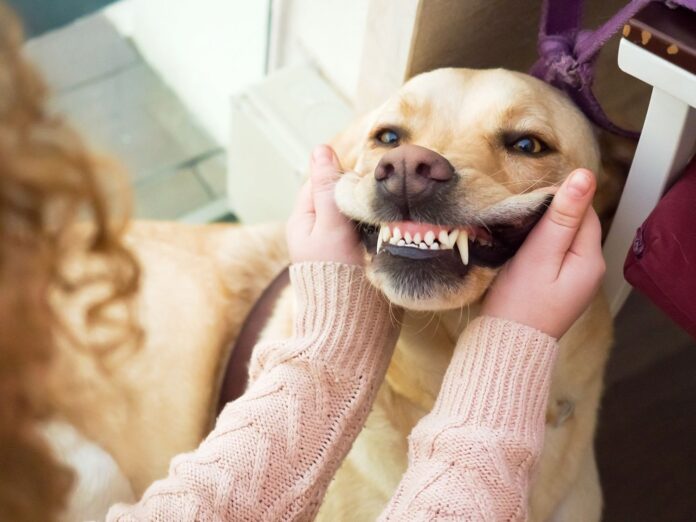Proper dental care is crucial for maintaining your dog’s overall health. Just like humans, dogs can develop dental issues such as plaque buildup, tartar, and gum disease, which can lead to more severe health problems if left untreated. Fortunately, there are several effective ways to ensure your dog’s teeth remain clean and healthy. Here’s a comprehensive guide to maintaining your dog’s dental hygiene.
1. Brush Your Dog’s Teeth Regularly
Regular tooth brushing is one of the most important ways to maintain your dog’s oral hygiene. Brushing helps prevent plaque and tartar buildup, which can lead to periodontal disease and tooth decay. Here are the steps to follow:
- Use a dog-specific toothbrush: Dog toothbrushes are designed to be gentle on gums and teeth, often with angled bristles to reach tricky spots.
- Use canine toothpaste: Human toothpaste contains ingredients like fluoride that can be harmful to dogs. Canine toothpaste comes in flavors like poultry or beef, making it more palatable for your pet.
- Introduce brushing gradually: If your dog isn’t used to brushing, start slowly. Let them lick a bit of toothpaste off the brush first to get accustomed to it. Then, gently brush a few teeth and increase the time spent brushing as they get more comfortable.
Aim to brush your dog’s teeth at least 2-3 times a week, though daily brushing is ideal.
2. Provide Dental Chews
Dental chews are an excellent way to promote good oral hygiene. These chews are designed to help scrape plaque off your dog’s teeth while they chew. Many are formulated with ingredients that reduce bacteria and freshen breath.
- Look for veterinary-approved dental chews that are safe and effective.
- Chews come in various sizes, so choose one that fits your dog’s breed and chewing habits.
These chews can supplement regular brushing and help maintain your dog’s dental health between brushings.
3. Offer Dental-Friendly Toys
Certain toys are designed to improve your dog’s dental health. Chewing on these toys can help remove plaque from the teeth and massage the gums. They also keep your dog engaged and mentally stimulated.
- Rubber or nylon chew toys: These durable toys can help remove plaque and tartar as your dog chews.
- Rope toys: Some rope toys have a flossing effect, cleaning between the teeth as the dog chews.
Make sure the toys you provide are safe and durable enough to withstand your dog’s chewing, and replace them if they become too worn.
4. Feed Your Dog Dental-Specific Diet
Some dog foods are specifically formulated to promote dental health. These dental diets are designed to reduce plaque buildup by encouraging mechanical chewing action and including ingredients that support oral health.
- Crunchy kibble: Some dry dog foods help reduce plaque by promoting a chewing action that scrapes the teeth.
- Veterinary-recommended diets: You can consult your vet about dental-specific foods that promote healthier teeth and gums.
5. Use Oral Rinses or Water Additives
Oral rinses and water additives are simple but effective ways to maintain your dog’s dental health. These solutions contain antibacterial properties that reduce plaque and freshen your dog’s breath.
- Oral rinses: Use a vet-approved oral rinse to swab your dog’s teeth and gums. These rinses are easy to apply and help combat plaque-causing bacteria.
- Water additives: Add these to your dog’s drinking water to promote fresher breath and reduce plaque. They are an effortless way to improve your dog’s oral health every time they drink.
6. Schedule Regular Professional Cleanings
Even with the best at-home care, your dog may still need professional cleanings from a vet. Veterinarians can conduct deep cleanings to remove tartar and plaque that can’t be reached by brushing or chews.
- Most dogs should have a professional dental cleaning at least once a year, although this may vary based on your dog’s breed and dental health.
- These cleanings require anesthesia to thoroughly clean your dog’s teeth and examine the mouth for any issues.
7. Watch for Signs of Dog’s Teeth Problems
Maintaining your dog’s oral health also involves monitoring for any signs of dental issues. Catching problems early can prevent them from becoming serious. Here are some common signs to look out for:
- Bad breath: Persistent bad breath may be a sign of dental disease.
- Inflamed or bleeding gums: Gum inflammation or bleeding can indicate gum disease.
- Excessive drooling: While some drooling is normal, excessive drooling may signal dental discomfort.
- Difficulty eating: If your dog seems hesitant to chew or eat, it could indicate pain caused by dental problems.
If you notice any of these signs, it’s essential to consult with your veterinarian to determine the cause and seek treatment.
8. Understand Breed-Specific Dental Needs
Some dog breeds are more prone to dental problems than others. Small breeds, such as Chihuahuas, Yorkies, and Dachshunds, are particularly susceptible to dental disease because of their smaller mouths and crowded teeth. These dogs may require more frequent brushing and dental checkups.
- Small breed dogs often need more dental attention, such as daily brushing and regular vet checkups.
- Brachycephalic breeds (such as Bulldogs and Pugs) with flatter faces can also be prone to dental issues due to misaligned teeth.
Keeping your dog’s teeth clean and healthy is essential to their overall well-being. With regular brushing, dental chews, toys, and professional vet care, you can help your dog maintain strong teeth and avoid painful dental diseases. By incorporating these practices into your dog’s routine, you’ll promote better oral hygiene and contribute to a happier, healthier life for your furry companion.











